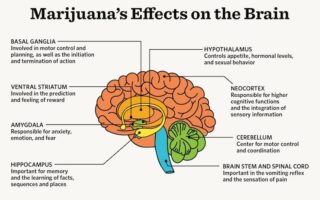As the lush green leaves of the cannabis plant sway gently in the breeze, a profound shift in societal perceptions and scientific inquiries unfolds around it. Once relegated to the shadows of controversy and stigma, marijuana is stepping into the spotlight as a subject of serious medical research and discussion. The allure of its multifaceted properties captivates scientists and patients alike, igniting curiosity about its potential to alleviate a myriad of ailments. From chronic pain to mental health disorders, the exploration of marijuana’s medicinal effects invites us to rethink what we know about this ancient plant. In this article, we delve into the heart of the matter, examining the emerging evidence, the mechanisms at play, and the promises and challenges that accompany its therapeutic use. Join us on this journey as we uncover the complexities of marijuana’s role in modern medicine.
Table of Contents
- Exploring the Cannabinoid Landscape for Pain Management
- Unveiling the Neuroprotective Benefits in Mental Health
- A Closer Look at the Therapeutic Potential for Chronic Illnesses
- Navigating Safe Consumption: Guidelines for Medical Use
- Q&A
- To Conclude
Exploring the Cannabinoid Landscape for Pain Management
As research continues to unravel the complex world of cannabinoids, a multitude of options are emerging for those seeking alternative pain relief solutions. The two most commonly studied cannabinoids, THC (Tetrahydrocannabinol) and CBD (Cannabidiol), have demonstrated significant therapeutic potential in managing chronic pain conditions. While THC is known for its psychoactive properties, its pain-relieving effects can provide substantial relief for conditions like arthritis and neuropathic pain. Conversely, CBD offers a non-intoxicating alternative that targets inflammation and anxiety, making it highly effective for a variety of pain-related issues.
Understanding the different administration methods and their impact on pain alleviation is crucial for patients. Here are some popular methods utilized:
- Inhalation: Quick onset of effects, typically used for acute pain relief.
- Edibles: Longer-lasting effects, ideal for chronic pain management.
- Tinctures: Flexible dosing; can be taken sublingually for faster absorption.
- Topicals: Direct application to target localized pain without systemic effects.
To effectively navigate the cannabinoid landscape, one can explore the following comparison of cannabinoid profiles aimed at pain management:
| Cannabinoid | Pain Relief Effectiveness | Primary Benefits |
|---|---|---|
| THC | High | Psychoactive relief, reduces nausea |
| CBD | Moderate | Anti-inflammatory, non-intoxicating |
| CBC (Cannabichromene) | Moderate | Potential analgesic properties |
Unveiling the Neuroprotective Benefits in Mental Health
Recent studies have highlighted the profound neuroprotective benefits associated with marijuana, establishing its potential role in enhancing mental health. Cannabinoids found in the plant, particularly THC and CBD, have demonstrated a capacity to shield the brain from various forms of damage. This protective effect is particularly significant in age-related cognitive decline and neurological disorders. It is believed that these compounds influence the endocannabinoid system, which plays a crucial role in regulating mood, memory, and emotional responses.
Furthermore, the incorporation of marijuana into therapeutic regimens has shown promise in alleviating symptoms linked to mental health conditions such as anxiety, PTSD, and depression. The ability of cannabinoids to modulate neurotransmitter release can help stabilize mood and promote feelings of well-being. Key findings around the medicinal use of marijuana include:
- Reduction of anxiety levels: Cannabidiol (CBD) has been particularly noted for its anxiolytic properties, helping users feel calmer.
- Improved cognitive function: Long-term studies suggest that certain cannabinoids can foster neurogenesis, enhancing brain health.
- Enhanced emotional regulation: Patients report increased emotional resilience when using cannabis in a therapeutic setting.
A Closer Look at the Therapeutic Potential for Chronic Illnesses
As research into the medicinal effects of marijuana gains momentum, the potential therapeutic applications for various chronic illnesses are becoming increasingly clear. Many patients have reported significant relief from symptoms associated with conditions such as chronic pain, anxiety, and even some autoimmune disorders. Scientific studies suggest that compounds found in marijuana, particularly cannabinoids like THC and CBD, interact with the body’s endocannabinoid system, which plays a crucial role in regulating pain, mood, and inflammation. This interaction not only helps manage discomfort but can also enhance overall quality of life.
Moreover, there is growing evidence to support the use of marijuana in the treatment of chronic illnesses such as multiple sclerosis, epilepsy, and Crohn’s disease. Some of the most compelling benefits include:
- Reduction of neuropathic pain: Many patients experience considerable relief from nerve-related pains.
- Anti-inflammatory properties: Cannabinoids have shown promise in reducing inflammation, which is crucial in autoimmune diseases.
- Seizure control: Specific strains and formulations have been effective in reducing the frequency of seizures among epileptic patients.
| Condition | Potential Benefit |
|---|---|
| Chronic Pain | Pain Relief |
| Anxiety Disorder | Anxiety Reduction |
| Multiple Sclerosis | Muscle Spasm Reduction |
| Epilepsy | Seizure Frequency Reduction |
| Crohn’s Disease | Anti-Inflammatory Effects |
Navigating Safe Consumption: Guidelines for Medical Use
When considering the medicinal use of marijuana, it’s essential to approach consumption with awareness and responsibility. Dosage plays a crucial role in achieving the desired effects without overwhelming side effects. Start with a low dose and gradually increase as needed, always being mindful of how it affects your body. Here are some key pointers to ensure a balanced approach to use:
- Consult a healthcare professional: Discuss your health conditions and potential interactions with other medications.
- Choose the right strain: Different strains offer various therapeutic effects, so selecting one tailored to your needs is vital.
- Consider the method of consumption: Smoking, vaping, edibles, and tinctures all have distinct onset times and durations of effect.
Additionally, maintaining a consistent consumption schedule can help regulate the benefits. It’s beneficial to track your experiences to identify patterns in how marijuana affects you over time. Below is a table outlining some popular consumption methods and their characteristics:
| Method | Onset Time | Duration |
|---|---|---|
| Smoking | Immediate | 1-3 hours |
| Vaping | Immediate | 1-3 hours |
| Edibles | 30 minutes to 2 hours | 4-8 hours |
| Tinctures | 15-45 minutes | 2-6 hours |
By prioritizing safety and informed choices, you can effectively navigate the therapeutic landscape of marijuana, ensuring a more beneficial experience tailored to your personal health goals.
Q&A
Q&A on the Medicinal Effects of Marijuana
Q: What are the primary compounds found in marijuana that contribute to its medicinal effects?
A: The two most notable compounds are tetrahydrocannabinol (THC) and cannabidiol (CBD). THC is primarily responsible for the psychoactive effects—what most people recognize as the “high”—while CBD is known for its therapeutic properties without the intoxicating effects. Together, these cannabinoids interact with the endocannabinoid system, which plays a crucial role in regulating various physiological processes.
Q: What health conditions can marijuana potentially help treat?
A: Research suggests that marijuana may alleviate symptoms associated with several conditions, including chronic pain, multiple sclerosis, epilepsy, anxiety disorders, and nausea caused by chemotherapy. Additionally, some studies indicate potential benefits in appetite stimulation for patients with HIV/AIDS and improving sleep quality for those with insomnia.
Q: How does marijuana differ from traditional medications used for similar ailments?
A: Unlike many pharmaceutical medications, marijuana offers a broader spectrum of effects, potentially addressing multiple symptoms at once. However, the way marijuana is metabolized in the body can lead to variable responses among individuals. Traditional medications often come with a definitive dosage and predictable outcomes, while marijuana’s efficacy may depend on the specific strain, dosage, and individual biology.
Q: Are there any significant side effects associated with marijuana use?
A: Yes, marijuana can have side effects, including dizziness, dry mouth, altered sensory perception, and impaired memory. Long-term use, particularly of high-THC strains, may lead to dependence in some individuals, as well as potential mental health issues. Thus, it is essential to weigh these risks against potential benefits, preferably under the guidance of a healthcare professional.
Q: How is marijuana administered for medicinal purposes?
A: Marijuana can be consumed in various ways, including smoking, vaporizing, or ingesting in food, known as edibles. Each method has a different onset time and duration of effects. For example, smoking may provide quick relief, while edibles take longer to kick in, but their effects can last longer. Topical applications are also available for localized relief without the psychoactive effects.
Q: Are there legal considerations regarding the use of medicinal marijuana?
A: Yes, the legality of medicinal marijuana varies significantly by region. In some places, it can be obtained with a doctor’s recommendation, while in others, it remains illegal. Patients should familiarize themselves with local regulations, including how to acquire a medical cannabis card if necessary, and the allowed forms and amounts of use.
Q: Is there ongoing research into the medicinal benefits of marijuana?
A: Absolutely! The landscape of cannabis research is constantly evolving. As attitudes toward marijuana shift and more states and countries legalize its use, researchers are increasingly focused on understanding its therapeutic potential and developing standardized treatments. This research aims to provide a clearer picture of the benefits and risks associated with marijuana, ultimately guiding informed decisions for patients and healthcare providers alike.
Q: What is the future outlook for medicinal marijuana?
A: With growing acceptance and continued research, the future of medicinal marijuana appears promising. There is potential for greater integration into medical practices, as well as the development of new strains and formulations that target specific conditions. However, it’s crucial for ongoing research to continue addressing safety, efficacy, and the social implications of using marijuana in medicinal contexts.
To Conclude
As we draw the curtains on our exploration of the medicinal effects of marijuana, it’s clear that this plant, with its complex chemistry and rich history, continues to challenge perceptions and inspire curiosity. From ancient remedies to modern research, marijuana offers a nuanced landscape where science and tradition intersect. While its potential benefits are undeniable, the path forward requires thoughtful consideration, open dialogue, and rigorous study. As we navigate this evolving dialogue, we stand on the brink of discovery—where the medicinal promise of marijuana is not just a matter of anecdote, but a burgeoning field ripe for investigation. Whether viewed through the lens of a patient seeking relief or a researcher uncovering its secrets, the quest for understanding the full spectrum of marijuana’s therapeutic effects is just beginning. In this evolving narrative, every insight brings us closer to harnessing the power of this remarkable plant for the betterment of health and well-being.


